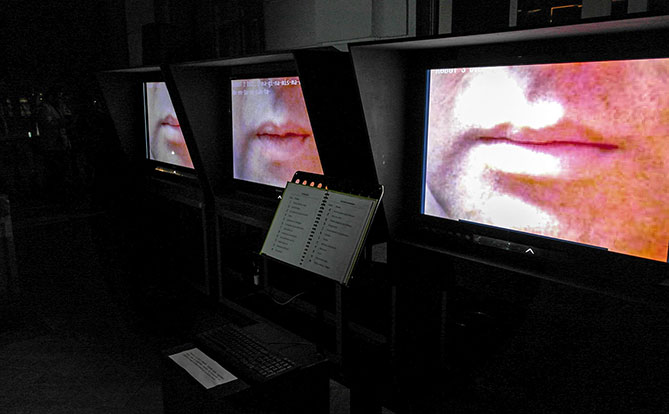|
The IP Poetry project involves the development of a software and hardware system that uses text from the Internet to generate poetry that is then recited in real time by automatons connected to the web.
The different search instructions (for example, all those phrases beginning with the words “dream that I am”) and the recital mode and sequence (one robot at a time per search result, dual recitals, etc.) will dictate the structure and form of each IP poem.
The recitals will be performed at various public venues. Using a proximity sensor, the system detects the presence of an audience and sends a command to the robots to start reciting the poems especially created for each event.
At that point the Internet search begins. The results are sent to the automatons (IP Bots), which convert the search results into the pre-recorded sounds and images of a moving human mouth.
As new text appears on a daily basis on the web, the poems recited maintain their structure, but the varying search results ensure a poem is never recited in the same way twice.
The IP Poetry project studies the role of poetry and of poets themselves. On the one hand, as far as the construction of the robots is concerned, it highlights the increasing subjectivity of technology, which is endowed with certain artificially enhanced human characteristics (in this case, memory, and the ability to speak and listen). On the other hand, as concerns the resulting poetic structures, it uses the virtual arrangement of the collective human memory found on the Internet to compose poetry that has both mechanical and random elements.

CREDITS
Idea and audiovisual presentation produced and directed by:
Gustavo Romano
www.gustavoromano.org
gusrom at gmail.com
Programming
Milton Laufer (Original version)
Gustavo Romano (Upgrades)
Acknowledgments
Yuyo Noé, Lidia Blanco, Margarita Paksa, Martín Weber, Carolina Romano, Antonio Franco
FUNDING
John Simon Guggenheim Memorial Foundation Fellowship, 2006
Award for the Advancement of Research at the international competition Vida 7.0 sponsored by the Telefónica Foundation Spain, 2004
Production support from the Telefónica Foundation, Argentina, 2006
Production support from the MEIAC (Museo Extremeño e Iberoamericano de Arte Contemporáneo) 2007
Ayuda para la promoción del arte contemporáneo español 2012

|